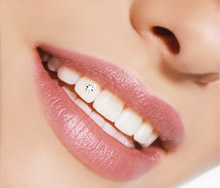
Sometimes in their professional life the dentists have to correct some dental defects. Any deviation from normal can be identified as a dental anomaly. As for its origin, it can be different as well as its effect which can range from stained teeth or tooth missing to cleft palates.
Certain teeth disturbances are related to embryonic development and appear at genetic level. One of such teeth anomaly is "amelogenesis imperfecta" when the teeth produce only a soft, thin layer of tooth enamel. This enamel is not capable to protect the teeth, so they are weak, susceptible and can be easily damaged. Moreover such teeth look
yellow because of dentin which shows through.
Another dental anomaly is microdontia which produces the teeth smaller then normal. More often it appears in the upper jaw and is limited to one or two teeth. This anomaly is harmless for the teeth health and there is only one desired effect to make the tooth the same size as the others. So, such tooth defect can be corrected by dentist using the crown.



















